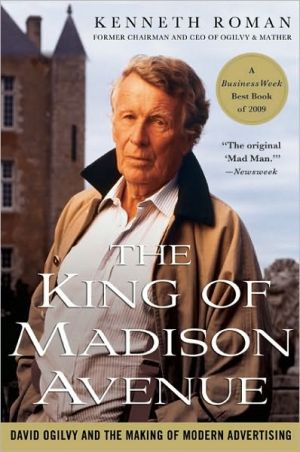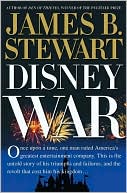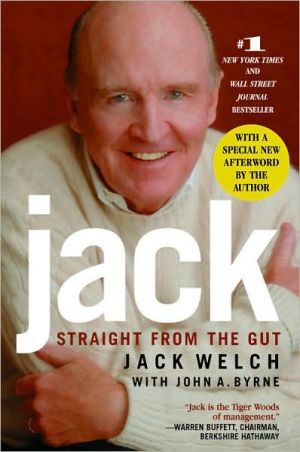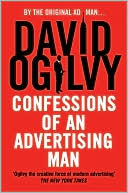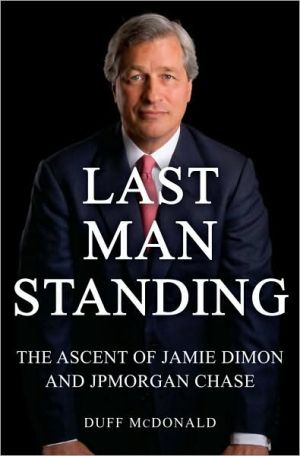The King of Madison Avenue: David Ogilvy and the Making of Modern Advertising
Famous for his colorful personality and formidable intellect, David Ogilvy left an indelible mark on the advertising world, transforming it from a disreputable business into a dynamic industry full of passionate, creative individuals. This biography is based on a wealth of material from the author’s decades of working alongside the advertising giant, including a large collection of photos, memos, recordings, notes, and extensive archives of Ogilvy’s personal papers.\ This biography is based...
Search in google:
Famous for his colorful personality and formidable intellect, David Ogilvy left an indelible mark on the advertising world, transforming it from a disreputable business into a dynamic industry full of passionate, creative individuals. This biography is based on a wealth of material from the author’s decades of working alongside the advertising giant, including a large collection of photos, memos, recordings, notes, and extensive archives of Ogilvy’s personal papers. This biography is based on a wealth of material from decades of working alongside the advertising giant, including a large collection of photos, memos, recordings, notes, and extensive archives of Ogilvy’s personal papers. The book describes the creation of some of history's most famous advertising campaigns, such as:* "The man in the Hathaway shirt" with his aristocratic eye patch* "The man from Schweppes is here" with Commander Whitehead, the elegant bearded Brit, introducing tonic water (and “Schweppervesence”) to the U.S.* Perhaps the most famous automobile headline of all time—“At 60 miles an hour the loudest noise in this new Rolls-Royce comes from the electric clock.”* “Pablo Casals is coming home—to Puerto Rico.” Ogilvy said this campaign, which helped change the image of a country, was his proudest achievement.* And his greatest (if less recognized) sales success—“DOVE creams your skin while you wash.”Fifty years later, still on his original proposition that it doesn’t dry your skin, Dove has become the largest selling cleansing brand in the world.Roman also carries Ogilvy's message into the present day, showing the contemporary relevance of the bottom-line focus for which his business ventures are remembered, and how this approach is still key for professionals in the modern advertising world. The Barnes & Noble Review Kenneth Roman, author of the first biography of advertising pioneer David Ogilvy, joined the firm Ogilvy & Mather in the early 1960s, around the same time in which the acclaimed television series Mad Men is set. But if you've been hooked by the goings-on at the fictional advertising agency Sterling Cooper, be warned: The King of Madison Avenue doesn't ooze the same seductive glamour as the AMC series. (Here's Roman on sex: "Whatever Ogilvy did outside his three marriages was discreet." Subject closed.) In his only mention of the show, the author, who eventually became Ogilvy's third successor as chairman of the agency, calls it "overblown."
\ From the PublisherPraise for The King of Madison Avenue:\ "Lively writing and an affectionate yet honest tone make this an astonishingly charming and informative biography."--Publishers Weekly (starred review) "Engaging biography ... Thanks to The King of Madison Avenue, now we know David Ogilvy."--Wall Street Journal "Roman has written a fine book on his former boss. He has a gem of a subject and, as well as a fund of anecdotes, he provides a clear-eyed, unsentimental portrait of a brilliant tyrant."--Financial Times "An entertaining and admiring portrait of the legendary figure ... [Roman's] many entertaining yarns delivered in spare prose are a pleasure to read."--BusinessWeek "Powerful and entertaining ... admirably researched and beautifully written."--James Brady, Forbes.com "An admiring but clear-eyed portrait of David Ogilvy."--New York Observer "Kenneth Roman's very readable biography presents an expansive and entertaining portrait, offering insights into the life and times ... Using Ogilvy's own books, quotes, other writings and reminiscences, copious interviews from friends, family, colleagues and competitors, Roman does a masterful job of conveying the colorful personality of Ogilvy ... Roman does his old boss proud."--Miami Herald "Comprehensive ... paints a broader picture of an industry's evolution."--Ad Age "Roman's admiring biography has its own charms ... a welcome assessment of the storied accomplishments that made him a legend to begin with."--Barnes & Noble “While reading this book, you receive an advertising 101 lesson on the genius of Ogilvy's vision…A definite read.”—Dan’s Papers "A unique and interesting story."--Nantucket Inquirer & Mirror "Entertaining, very well researched."--Winnipeg Free Press "If you are in advertising, you need to grab Kenneth Roman’s biography on David Ogilvy ... This is a fantastic book."--London Calling Mobile Advertising blog “Insofar as it is possible to recreate the unique wit and always unexpected genius of David Ogilvy, Kenneth Roman has succeeded.”--Louis Auchincloss, National Medal of Arts winner and best-selling author of The House of Five Talents, Portrait in Brownstone, East Side Story, and many more\ “At last! The definitive biography of the most influential advertising executive with whom I had the pleasure of working. Ken Roman’s research diligence has brought much more of David’s uniqueness to light. A great read from someone who worked with David for 26 years!”--Jack Keenan, former CEO of Kraft Foods International, and Diageo PLC Wine and Spirits\ “David Ogilvy was unquestionably the King of Madison Avenue. Ken Roman's biography reflects his personal insights gained from being a colleague of Ogilvy's for several decades. This intimate portrayal makes clear Ogilvy's inspiring leadership of his agency even though he abhorred his managerial tasks. Ogilvy's convictions about what made for effective advertising -- it sells -- are clearly described by Roman, as is his brilliant personal salesmanship in winning new clients. A terrific read!”--Ron Daniel, former Managing Partner, McKinsey & Co.\ "This brilliant biography is like a gorgeous iceberg. The tip dazzles the reader and is supported by a mass of weighty research below. Kenneth Roman enchants us with his account of the life and times of David Ogilvy who towered above the world of advertising … It should be required reading for all in the business … The story is told swiftly and entertainingly. The voluminous research is set out in detailed notes at the back, and these also grip the attention of those who want to know how so much could be told with such flair, and why the author can paint a background of historical events with such certainty."--William Stevenson, author of A Man Called Intrepid\ “This is a surprisingly interesting book about one of the most remarkable characters in advertising history. It is also an introduction to the business itself and how it has been conducted, in sickness and in health, by someone who lived the experience.”--Martin Mayer, author of Madison Avenue USA\ “A great biography of a truly great man. David Ogilvy rewrote the book on modern advertising, and with The King of Madison Avenue, Ken Roman tells his story in a fashion that is worthy of David’s accomplishments. Extensively researched and very well written. Give this book to any young person thinking about going into advertising. It will inspire them.”--Philip Carroll, former CEO of Shell Oil\ “A most interesting book. It is a sensitive account of the career of this complex man who so successfully melded intuition and analysis. It should be compulsory reading for anyone contemplating a career in advertising or communications.”--Sir Michael Angus, former Chairman, Unilever\ “Nobody ever need write another word about David Ogilvy, now that Ken Roman has written The King of Madison Avenue. It’s the definitive biography of the most amazing man the advertising business has ever known. With David Ogilvy as the subject, how could you miss? Ken Roman doesn’t miss; this is the fairest, most thoughtful, most complete and most human biography of that flawed genius we are ever likely to get … Ken Roman has penetrated the myths and written the definitive story, warts and all, of the greatest advertising man and one of the most unforgettable characters of his time. The King of Madison Avenue is to other advertising biographies as David Ogilvy’s advertising was to that of other agencies: simply superior. Everyone who ever knew David Ogilvy will find something about the man they didn’t know, and those who never knew David Ogilvy will have a rollicking good time getting to know him. This has to be the most readable book ever written about advertising.”--Bruce McCall, New Yorker writer and illustrator\ "Ken Roman has hit a home run."--Louis Begley, prize-winning author of Wartime Lies and other novels\ “A wonderful job recounting the life of so complicated a person. Beautifully written.” – Harold Burson, founder, Burson-Marsteller Public Relations\ "The book is affectionate but balanced, erudite but immensely readable, surprising, witty ... and as remarkable as its subject."--David Abbott, Former Chairman, Abbott Mead Vickers BBDO\ Praise for Kenneth Roman's previous books: Writing that Works "The Strunk and White of business writing."--Louis Begley\ "Clear, concise communications that make the right point will launch your career or business to new heights."--Robert Seelert, Chairman, Saatchi & Saatchi PLC How to Advertise\ "Worth its weight in gold."--David Ogilvy\ A timeless treasure of the enduring principles that everyone in the advertising supply chain--those who create, place, manage, review and approve--should read over and over again. It's the definitive roadmap to creating great work."--James Speros, Chairman, Association of National Advertisers\ "Without pulling any punches, the book tells readers what works."--Dallas Morning News\ \ \ \ \ \ Publishers WeeklyRoman, former chairman and CEO of Ogilvy & Mather, paints a fascinating portrait of one of advertising's most eccentric-and beloved-characters. Born in a small English town in 1911, David Ogilvy was an indifferent student, struggling through on scholarship at the best schools in Britain, eventually getting himself expelled from Oxford. He started out as a successful salesman for the Aga cooker and became swiftly obsessed with advertising. During his long and storied career at Mather & Crowther-later Ogilvy & Mather-the flamboyantly dressed original "Mad Man" crafted some of the most famous and most successful campaigns in history: he made Schweppes into one of the most popular brands in America and turned Marlboro from a traditionally feminine item (red-tipped to avoid showing lipstick) into an icon of masculinity-and the world's best-selling cigarette. Meanwhile, he married three women, wrote three books, did intelligence work for Churchill and established himself as one of New York's most well-known and entertaining figures. Roman brilliantly renders American culture in the heady days of the '60s through the eyes of an energetic transplant. Lively writing and an affectionate yet honest tone make this an astonishingly charming and informative biography. (Jan.)\ Copyright © Reed Business Information, a division of Reed Elsevier Inc. All rights reserved.\ \ \ Library JournalRoman (coauthor, How To Advertise) worked directly with David Ogilvy, a legend in the world of advertising, as CEO and chair of Ogilvy & Mather (O&M) and had his professional coming-of-age at the firm after Ogilvy had become a celebrity. His book doesn't break any new ground, but it provides context for O&M's success, which is largely based on the ability to sell by using smart ideas that appeal to buyers. Roman mourns the passing of the golden age of advertising, and his book may appeal to others who see a new era in which advertising agencies do not play the role they once did; today, marketing dollars are being invested in online advertising and direct response. Ogilvy's books about his approach, the most famous of which is Confessions of an Advertising Man, offer timeless insights about benefits to buyers. Mark Tungate's 2007 Adland is one of the most comprehensive books on the history of advertising. Given the number of books on the topic, Roman's is recommended only for libraries with large collections on advertising.\ —Stephen Turner\ \ \ \ \ \ Kirkus ReviewsThe former chairman and CEO of Ogilvy & Mather offers a portrait of the ad agency's legendary founder. Roman begins with expatriate Brit David Ogilvy, nearly 40, quietly opening his first Manhattan office on Madison Avenue in 1948 after short stints as a chef, a poll researcher for Gallup and an Amish country farmer. A business novice with negligible advertising experience, known to don a "full-length flowing black cape with a scarlet lining" that made him look "like Heathcliff coming off the moors," Ogilvy took the advertising industry by storm in just ten years. He started small then advanced quickly with an unmatched portfolio of campaigns for high-profile companies like Schweppes, Dove, Tetley Tea, Pepperidge Farm and Rolls-Royce. Culled from memories of his 26-year stint working alongside Ogilvy, plus nearly 200 interviews with business contemporaries and close acquaintances, Roman reveals how the ad man earned his peers' supreme respect with his interrogative, disarming presence, yet retained an outspoken shrewdness. The author does note, however, that while Ogilvy achieved many public accolades throughout his professional career, his personal life was troublesome. His first two marriages ended in divorce, and he never fulfilled his desire for a large family. His not-terribly-happy childhood was scanted in his 1978 autobiography Blood, Brains and Beer; Roman fills in the blanks here. Plagued with chronic asthma, he had "a distinctly original mind" that did not jibe with his teachers at an oppressive British boarding school or at Oxford. His grades suffered, and he struggled with low self-esteem. Psychotherapy in middle age revitalized and overstimulated his suppressed ego; he couldbe, the author notes, "self-centered and inconsiderate." Ogilvy retired to a palatial French chateau in 1973 and died in the summer of 1999, leaving behind an unrivaled advertising legacy. An afterword containing unpublished correspondence and a generous selection of photographs draws readers further into his world. Straightforward, well-crafted biography of the outsider who shaped American advertising. First printing of 75,000\ \ \ \ \ The Barnes & Noble ReviewKenneth Roman, author of the first biography of advertising pioneer David Ogilvy, joined the firm Ogilvy & Mather in the early 1960s, around the same time in which the acclaimed television series Mad Men is set. But if you've been hooked by the goings-on at the fictional advertising agency Sterling Cooper, be warned: The King of Madison Avenue doesn't ooze the same seductive glamour as the AMC series. (Here's Roman on sex: "Whatever Ogilvy did outside his three marriages was discreet." Subject closed.) In his only mention of the show, the author, who eventually became Ogilvy's third successor as chairman of the agency, calls it "overblown." \ Oh well. But Roman's admiring biography has its own charms, even if those don't include office trysts and martini-soaked lunches. He sets out to explain how Ogilvy, an eccentric Brit who opened shop on Madison Avenue in 1948 with virtually no advertising experience, managed to create some of the most enduring advertising campaigns -- for Hathaway shirts, Schweppes, Rolls-Royce, and Dove soap, among others -- of the 20th century.\ Ogilvy, born in a rural village in Surrey in 1911, grew up in what Roman calls "genteel poverty." His father was Scottish, and Ogilvy identified as a Scot throughout his life (he was known to don a kilt on many occasions). He attended boarding school on scholarship and had a miserable experience; after two years at Oxford, he left without a degree.\ Following a brief stint as a cook in Paris, Ogilvy found a job through his brother Francis, who worked for the London advertising agency Mather & Crowther. One of the firm's clients was the Aga Cooker -- a stored-heat stove recently introduced in Great Britain -- and Francis set David up selling the Aga door-to-door. Ogilvy proved so successful at hawking an expensive appliance in the midst of a depression that the company hired him to write a sales guide for all its employees. "Published in 1935, when Ogilvy was 24 years old, 'The Theory and Practice of Selling the Aga Cooker' became the company's sales bible," Roman writes of the 32-page booklet. "In an article about him 30 years later, Fortune thought it 'probably the best sales manual ever written.' "\ Through his experience with the Aga, Ogilvy formed views on salesmanship that he held stubbornly throughout his career. Ogilvy's iconic ads featured copious amounts of copy, and he created them by imagining that a housewife had let a traveling salesman through the door. "You talk to the housewife personally, and you tell her what your product would do for her," he wrote years later, at a time when jingly television commercials were all the rage. "You don't stand there and sing at her; she would think you were a lunatic."\ Based on the strength of his Aga manual, Ogilvy was hired as a trainee at Mather & Crowther. He "studied the business feverishly, reading everything he could find," Roman writes. The brash young man convinced the agency to send him to the United States to study American advertising. According to Roman, "He would return a year later to tell his elders precisely what they were doing wrong."\ Before long, Ogilvy moved to the United States; Roman speculates that he wanted to prove himself without the help of his brother, who was by then chairman of Mather & Crowther. He became the first employee of George Gallup's Audience Research Institute, polling moviegoers on the popularity of movie stars and testing story ideas (another formative experience, giving him a lifelong faith in advertising based on consumer research). He left Gallup during World War II to work in military intelligence for the British Embassy in Washington. After the war, he and his wife bought a farm in Lancaster County, Pennsylvania, and lived among the Amish, growing tobacco. When Ogilvy tired of that lifestyle, he at last returned to advertising, opening the American outpost of Mather & Crowther.\ Within a decade of the agency's launch, Ogilvy had created most of the campaigns for which he is famous. All rooted in his insistence that advertising should inform, not entertain, they followed the same pattern: a photograph, a headline beneath the photo, and three blocks of text beneath that. "The Man in the Hathaway Shirt" ad, featuring a distinguished middle-aged man wearing an eye patch, became a sensation. "It was the first time shirt advertising focused as much on the man wearing the shirt as on the shirt itself," writes Roman, noting that Ogilvy added the patch to give the ad "story appeal." Schweppes, a British beverage brand, was virtually unknown in the United States when Ogilvy put the company's handsome, thickly bearded U.S. president, Commander Edward Whitehead, in the ads, making him the spokesman for "Schweppervescence." Sales shot up 600 percent in six months. And the headline of his Rolls-Royce ad, "At 60 miles an hour, the loudest noise in this new Rolls-Royce comes from the electric clock," sealed his place in advertising history, even after it was discovered that an almost identical line had appeared in a Pierce Arrow ad in the 1930s.\ Ogilvy's first book, Confessions of an Advertising Man, became a bestseller in 1963, making him a celebrity. Shortly thereafter, the London and New York agencies merged, becoming Ogilvy & Mather, with David Ogilvy as chairman. His creative output slowed down, and ten years later he moved to a château in France, from where he produced "a tsunami of memos, letters, speeches, papers, and projects." He retained his stature, but the combination of distance and age made many colleagues feel he was out of touch. The committed print man never warmed to television advertising, and Roman gives the impression that he became a bit of a crank. In a videotaped message sent to the ceremony presenting the Advertising Research Foundation's first David Ogilvy Research Award, he ranted, "Nowadays...agencies are dominated by specialists in television. Their ambition is to win awards at festivals. They don't give a damn whether their commercials sell." By the time he reached his 70s, his role in the agency was largely ceremonial. He died in France in 1999, at the age of 88.\ The author, who left Ogilvy & Mather after its hostile takeover by a British holding company in 1989, is an endearing, if at times repetitive, narrator of this life story. He clearly holds his subject in high esteem, and he doesn't seem particularly concerned with resolving the many contradictions of his onetime boss, who could be both open-minded and narrow, courtly and boorish. Retelling an old Ogilvy anecdote, Roman concludes, "That is his story, and it might even be true." But while the book may not penetrate the man behind the legend, it is nonetheless a welcome assessment of the storied accomplishments that made him a legend to begin with. --Barbara Spindel\ Barbara Spindel has covered books for Time Out New York, Newsweek.com, Details, and Spin. She holds a Ph.D. in American Studies.\ \ \
